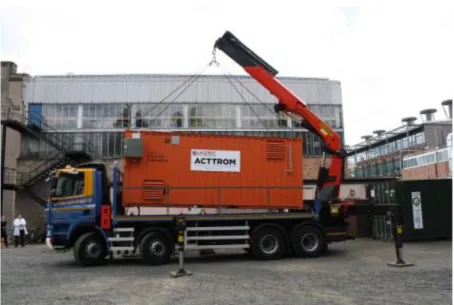1
A Transportable Remotely-Operated Research Facility for Industrial
Post-Combustion CO
2Capture Technologies under Accelerated Conditions
Chih-Wei Lin,*,1 Grégoire Léonard,2 Jon Gibbins3, Mathieu Lucquiaud1 1
School of Engineering, The University of Edinburgh, King's Buildings, Edinburgh, UK, EH9 3FB
2
Department of Chemical Engineering, University of Liège, Allée de la Chimie B6A, Liège 4000, Belgium
3
Department of Mechanical Engineering, The University of Sheffield, Sheffield, UK, S10 2TN
Abstract
CO2 post combustion capture technology with chemical sorbents can easily be retrofitted onto existing power plants; therefore, it has been widely believed as one of optimized package solutions to offer huge CO2 reduction from existing emitters. One key challenge is the management of solvent composition as chemical sorbents are exposed to process impurities, oxygen and thermal cycling. Solvent degradation may, for example, account for up to 22 % of process operating expense (OPEX) and affect the CO2 capture efficiency.1 One challenge is to assess solvent behaviour over extended period of time, and quantify solvent degradation for process optimization. In the context of widespread deployment of CCS to a range of fuels in power generation and a range of industrial emitters, it is essential to assess solvent ageing at different industrial sites since flue gases impurities vary greatly for challenging fuels, e.g. recycled wood, or industrial processes, e.g. blast furnace gas in steelworks.
The Advanced Capture Testing in a Transportable Remotely-Operated Minilab (ACTTROM) is a transportable test facility operated at industrial sites for bench-scale evaluation of post-combustion CO2 capture technologies under realistic industrial flue gases.2 Hence, use of ACTTROM takes huge advantages to investigate realistic solvent degradation mechanisms at industrial sites. However, chemical reactions involved in the degradation of amine solvents are typically slow, for example, 4 % (mass or volume) of solvent degradation in 45 days during pilot plant test.3
An accelerated solvent degradation test rig developed by Léonard et al.4 for accelerating the degradation of solvents at pressure up to 0.5 MPa and temperature up to 393 K showed that similar degradation pathways and products can be obtained, when compared with two European CO2 capture pilot plants. This indicates that accelerated solvent degradation test rig reproduces and accelerates the same degradation mechanisms as those observed in large-scale industrial processes. For the first time, an accelerated solvent degradation test rig has been integrated into ACTTROM to significantly reduce the duration of test campaings on site and improve predictions of changes in solvent ‘quality’ over time. This article includes solvent degradation results from a test campaign at a power station using virgin and recycled wood as their primary fuel. It showcases the unique route to a “technology development model” to (i) support commercialisation pathways of solvent technology suppliers, who require access to realistic test conditions to de-risk their processes; (ii) support large carbon dioxide emitters with dedicated technology assessment under realistic process conditions at their site.
2
Figure 1: Exterior view of the ACTTROM unit being loaded prior to transport References
1. M. Abu Zahra, L. Schneiders, J. Niederer, P. Feron, G. Versteeg, CO2 capture from power plants: Part II. A parametric study of the economical performance based on mono-ethanolamine, Int. J. Greenhouse Gas Control 2007, 1, 135
2. R. Watson, M. Lucquiaud, J. Gibbins, Development of a portable facility for in-situ testing of carbon capture technologies, 2nd Post Combustion Capture Conference (PCCC2), 2013
3. H. Lepaumier, Etude des mécanismes de dégradation des amines utilisées pour le captage du CO2 dans les fumées, PhD thesis, University of Savoie, France 2008
4. G. Léonard, D. Toye, G. Heyen, Relevance of accelerated conditions for the study of monoethanolamine degradation in post-combustion CO2 capture, The Canadian Journal of Chemical Engineering, 2014, 93(2) 348-355
